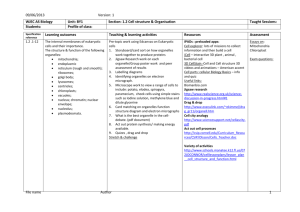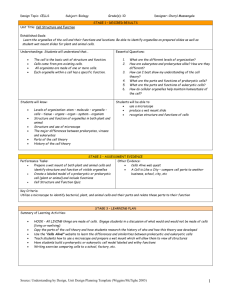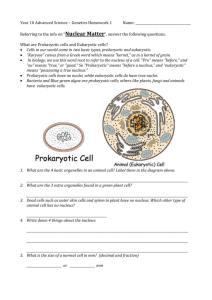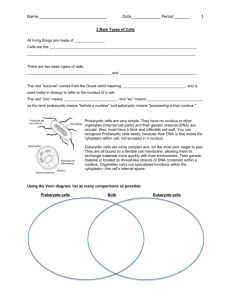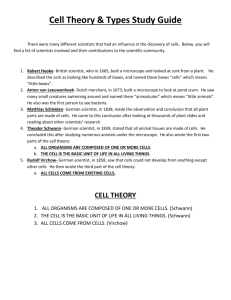LABORATORY GUIDE NATURAL SCIENCE AND
advertisement
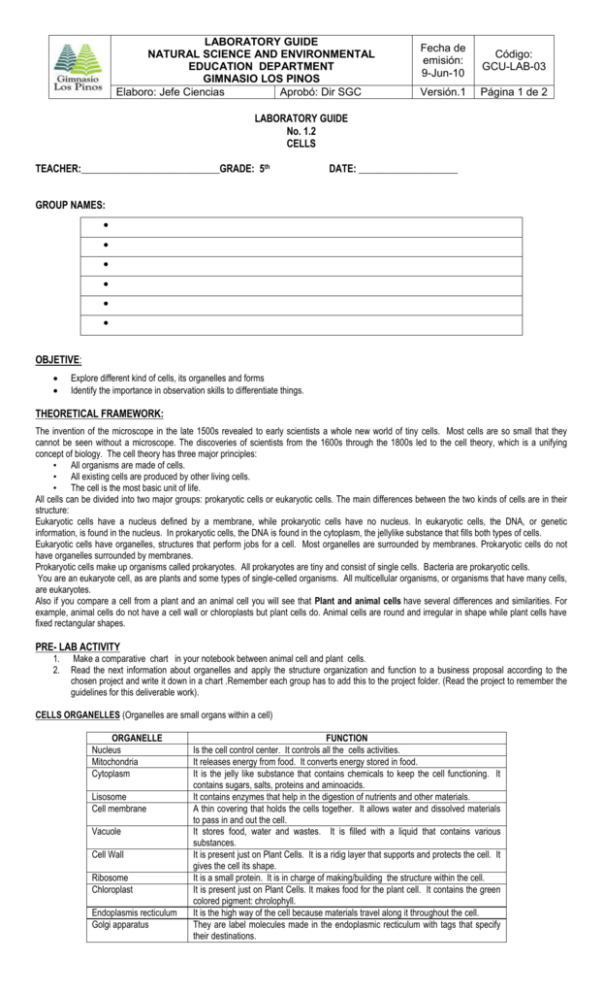
LABORATORY GUIDE NATURAL SCIENCE AND ENVIRONMENTAL EDUCATION DEPARTMENT GIMNASIO LOS PINOS Elaboro: Jefe Ciencias Aprobó: Dir SGC Fecha de emisión: 9-Jun-10 Código: GCU-LAB-03 Versión.1 Página 1 de 2 LABORATORY GUIDE No. 1.2 CELLS TEACHER:____________________________GRADE: 5th DATE: ____________________ GROUP NAMES: OBJETIVE: Explore different kind of cells, its organelles and forms Identify the importance in observation skills to differentiate things. THEORETICAL FRAMEWORK: The invention of the microscope in the late 1500s revealed to early scientists a whole new world of tiny cells. Most cells are so small that they cannot be seen without a microscope. The discoveries of scientists from the 1600s through the 1800s led to the cell theory, which is a unifying concept of biology. The cell theory has three major principles: • All organisms are made of cells. • All existing cells are produced by other living cells. • The cell is the most basic unit of life. All cells can be divided into two major groups: prokaryotic cells or eukaryotic cells. The main differences between the two kinds of cells are in their structure: Eukaryotic cells have a nucleus defined by a membrane, while prokaryotic cells have no nucleus. In eukaryotic cells, the DNA, or genetic information, is found in the nucleus. In prokaryotic cells, the DNA is found in the cytoplasm, the jellylike substance that fills both types of cells. Eukaryotic cells have organelles, structures that perform jobs for a cell. Most organelles are surrounded by membranes. Prokaryotic cells do not have organelles surrounded by membranes. Prokaryotic cells make up organisms called prokaryotes. All prokaryotes are tiny and consist of single cells. Bacteria are prokaryotic cells. You are an eukaryote cell, as are plants and some types of single-celled organisms. All multicellular organisms, or organisms that have many cells, are eukaryotes. Also if you compare a cell from a plant and an animal cell you will see that Plant and animal cells have several differences and similarities. For example, animal cells do not have a cell wall or chloroplasts but plant cells do. Animal cells are round and irregular in shape while plant cells have fixed rectangular shapes. PRE- LAB ACTIVITY 1. 2. Make a comparative chart in your notebook between animal cell and plant cells. Read the next information about organelles and apply the structure organization and function to a business proposal according to the chosen project and write it down in a chart .Remember each group has to add this to the project folder. (Read the project to remember the guidelines for this deliverable work). CELLS ORGANELLES (Organelles are small organs within a cell) ORGANELLE Nucleus Mitochondria Cytoplasm Lisosome Cell membrane Vacuole Cell Wall Ribosome Chloroplast Endoplasmis recticulum Golgi apparatus FUNCTION Is the cell control center. It controls all the cells activities. It releases energy from food. It converts energy stored in food. It is the jelly like substance that contains chemicals to keep the cell functioning. It contains sugars, salts, proteins and aminoacids. It contains enzymes that help in the digestion of nutrients and other materials. A thin covering that holds the cells together. It allows water and dissolved materials to pass in and out the cell. It stores food, water and wastes. It is filled with a liquid that contains various substances. It is present just on Plant Cells. It is a ridig layer that supports and protects the cell. It gives the cell its shape. It is a small protein. It is in charge of making/building the structure within the cell. It is present just on Plant Cells. It makes food for the plant cell. It contains the green colored pigment: chrolophyll. It is the high way of the cell because materials travel along it throughout the cell. They are label molecules made in the endoplasmic recticulum with tags that specify their destinations. LABORATORY GUIDE NATURAL SCIENCE AND ENVIRONMENTAL EDUCATION DEPARTMENT GIMNASIO LOS PINOS Elaboro: Jefe Ciencias Aprobó: Dir SGC Fecha de emisión: 9-Jun-10 Código: GCU-LAB-03 Versión.1 Página 2 de 2 LABORATORY PRACTICE MATERIALS: Microscopes by groups Onion Swabs Insect Swabs Plastic gloves Methylane blue Facemasks Lab coat PROCESS AND ACTIVITIES 1. 2. 3. Slide # 1 ONION SKIN Observe the onion swabs using the microscope In your notebook draw an onion cell Describe the cell .( color, shape, number of nucleus, what else can you see?) Slide # 2 4. 5. 6. ANIMAL PART ( insect) Observe the animal swabs using the microscope In your notebook draw an animal cell Describe the cell .( color, shape, number of nucleus, what else can you see?) ANALYSIS AND INTERPRETATION 7. Compare both experiences and answer in your notebook What are the main differences between the slide #1 and slide #2? Compare them in all aspects Draw a comparative chart taking into account color, shape, size, nucleus, organelles( if you saw some with the microscope) BIBLIOGRAPHY http://www.az-microscope.on.ca/history.htm http://homeschooling.about.com http://sciencespot.net http://www.diffen.com/difference/Animal_Cell_vs_Plant_Cell
